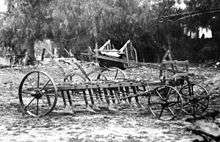Stump-jump plough
The stump-jump plough is a kind of plough invented in South Australia in the late 19th century by Richard Bowyer Smith to solve the particular problem of preparing mallee lands for cultivation.


The problem
Mallee scrub originally covered large parts of southern Australia, and when farmers moved into these areas they found it peculiarly difficult to clear the land. After the trees were cut down, the roots energetically produced regrowth. These young shoots and the old roots could be killed by repeated burning (see below), but the large roots remained in the ground, making it impossible to plough the soil. Grubbing the roots out was a slow and labour-intensive activity, and the problem was seriously hindering agricultural expansion.
In South Australia, land was being offered under the Scrub Act of 1866 to farmers on lease, with the option of purchasing after 21 years at the price of £1 per acre. However, grubbing the scrublands was proving costly, at approximately £2 per acre, and solutions to the problem were desperately sought.
Solutions
The situation had grown to be so frustrating by 1878 that the South Australian government offered a reward of £200 to anyone who could develop an effective mechanical stump puller; although myriad devices were developed, none proved to be a breakthrough success. Many of these machines were trialled in contests near Gawler in the same year, but none were as effective as three skilled axemen.
Pending the development of an effective machine, a technique known as mullenizing (after a farmer from Wasleys named Charles Mullen) became popular as a means of clearing the scrub. Mullenizing involved dragging a heavy roller over roughly cleared ground to crush young shoots; the field was then burnt, and a spiked log was run over the ground, and a crop of wheat sown. The next season, the stubble and any mallee regrowth was again burnt, and eventually the mallee died, though stumps remained underground.
Breakthrough
In 1876 a special plough was invented by agricultural machinery apprentice Richard Bowyer Smith, and later developed and perfected by his brother, Clarence Herbert Smith,[1] on the Yorke Peninsula (where the problem was particularly acute). The plough consisted of any number of hinged shares: when the blade encountered an underground obstacle like a mallee stump, it would rise out of the ground. Attached weights forced the blade back into the ground after the root was passed, allowing as much of the ground to be furrowed as possible. Although a little unorthodox, the plough in action appearing "like a ship in a storm",[2] it proved remarkably effective, and was dubbed the "stump-jump" plough.
The invention was hailed as a "complete revolution"[3] and, in combination with the process of mullenizing, was adopted almost universally across the mallee lands, even proving as useful in stony ground as it was in mallee country. There is a plough on display in Ardrossan, with a Historic Engineering Marker plaque attached.[4]
Another successful stump jump plough was invented in 1877 by James Winchester Stott (1830-1907) who was a very prolific inventor in Alma in the mid North of South Australia. Not only did he invent a stump jump plough he also invented a cultivator, slasher, scarifier and double furrow plough.[5] Stott and Mellor Brothers, who had refined Stott's design, were jointly the first to patent a stump-jumping plough in Victoria.[6]
A working model of the R.B. Smith Double Furrow Plow is held by the Powerhouse Museum in Sydney. It is very finely crafted and was made in 1883 by Albert Arnold, then a young Journeyman blacksmith. His family moved to Dowlingville (near Ardrossan) on the Yorke Peninsula in 1876 <7> to take up land. He and his father John, also a blacksmith, made numerous modifications over several years and participated in local ploughing competitions. Albert moved to Sydney in 1882 and endeavoured to have his new employer manufacture the plow, hence the model. Albert left considerable family papers including diagrams and photos of his work. Eventually the model and another 25 models and NSWGR inventions were given to the then Technological Museum and are available to viewers on request.
References
- 100 Years of Australian Innovation - stump-jump plough
- D.W. Meinig, On the Margins of the Good Earth, Rigby, 1962, 106
- Ibid,105
- "Smith's Stump-Jump Plough, 1876-". Engineering Heritage Register. Engineers Australia. Retrieved 14 June 2016.
- "James Winchester Stott". The Stott Family. Retrieved 14 June 2016.
- "Stump Jumping Plough". The Advertiser (Adelaide). South Australia. 17 February 1934. p. 22. Retrieved 2 October 2017 – via National Library of Australia.
- Arnold family papers including newspaper articles held by G.Stevenson